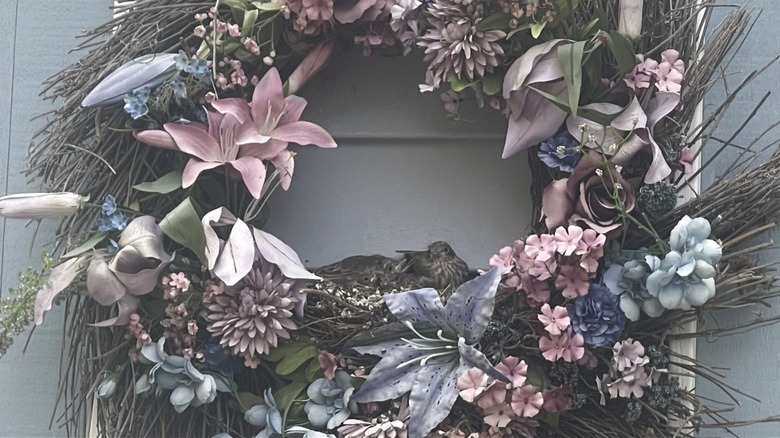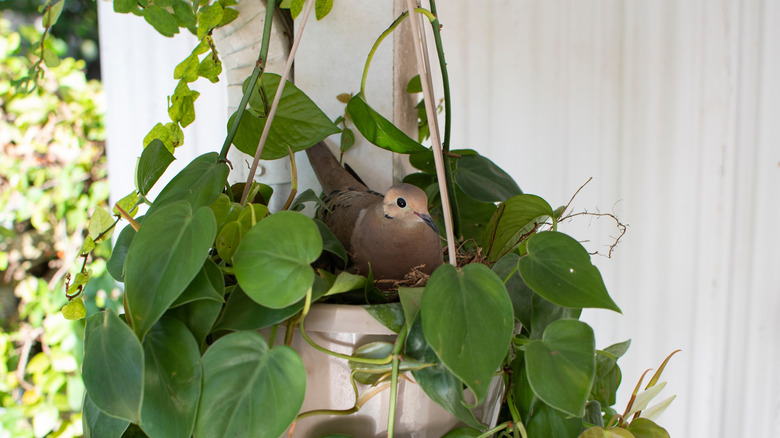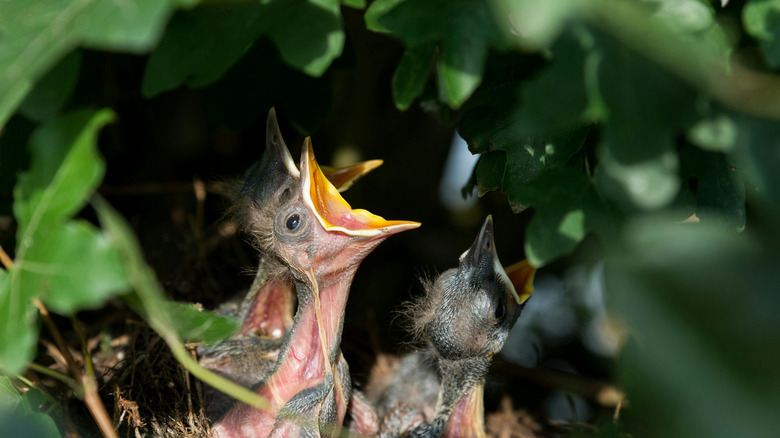The Overlooked Solution To Stop Birds From Nesting In Your Wreaths Is So Simple
Watching a few feathered friends enjoy your yard is one of the most relaxing ways to spend time — until a bird decides to nest in the wreath hanging on your front door. Perhaps you've spotted one suspiciously carrying mouthfuls of nesting material toward your porch. Or maybe it's hard to tell who was startled more: Your weekend houseguests or the bird who suddenly flew at them when they rang the doorbell. We spoke to Robyn Bailey, project leader for NestWatch, a participatory science project administered by the Cornell Lab of Ornithology, about simple solutions to stop birds from nesting in your wreaths that you shouldn't overlook. According to Bailey, choosing simpler wreaths and providing alternatives like hanging baskets are great choices.
"The birds that typically nest in wreaths are species that would be likely to nest on our homes in other nooks and crannies as well," Bailey said during an exclusive interview with House Digest. "What they really like about our porches, patios, and garages is the shelter they offer from rain, heat, and predators," she added. The Certified Wildlife Biologist went on to explain that birds choose wreaths because they often look like greenery or offer a sturdy base for building their nests. "There tends to be a handful of species that do this, like house finch, American robin, Carolina wren, mourning dove, and even dark-eyed junco," she said. Although these are among the types of birds you want in your yard, they can quickly ruing your decorative wreaths. Not just by the organic matter used to make the nests either — the detritus created as chicks hatch and pathogens left behind can also be damaging.
Opt for narrow wreaths and offer alternatives
You may be surprised to learn that birds aren't all that picky about what your wreath is made from or how it's decorated. What's more important is that it provides the security they need for their nest. "I have seen plenty of nests on wreaths made of synthetic greenery, and some that don't look natural at all," Robyn Bailey told House Digest during her exclusive interview, adding that one American flag nest came to mind. She recommended choosing a wreath style that has fewer elements because flowers, ribbons, and other wreath accessories create appealing camouflage for birds. The shape of your wreath may also make a difference. "The nest will almost always be placed on the inside bottom of the wreath, using the door and the wreath as a support," Bailey explained. "If you'd like to discourage most birds, choose a wreath that is very narrow which lacks the wide base of support they want for their nest."
You can also keep birds from nesting in wreaths by providing them with nearby alternatives. "Have some other options for safe nesting places, such as potted plants, hanging baskets, a nest shelf or nook, or maybe a trellis with vines growing on it," Bailey suggested. Birdscaping can turn your yard and garden into a bird haven, and the expert said birds would also nest on stacked firewood, in coiled garden hoses, and even inside upside-down bike helmets. "The more suitable options you provide, the less likely it is that the wreath will seem like the best one," she explained.
Don't remove or relocate bird nests no matter where you find them
But what should you do if it's too late and a bird has already made a nest in your wreath? "Respect the law protecting them and do not try to remove or relocate them," Robyn Bailey emphasized during her exclusive interview with House Digest. "This is illegal and likely to result in a nest failure for the birds." She recommended using a different entrance if at all possible, and if not, to disturb the wreath as little as possible. "If you only have one door, consider placing your wreath on a wall or post nearby so you don't end up in this situation," she told us.
Finding a nest in your wreath means that birds think your home is a safe space, and that's not a bad thing! Waking up to their cheerful chirps is a sought-after experience, and attracting songbirds to your yard may reduce stress and improve your mental health. According to Bailey, "Most small songbirds' nests take about 30 days from egg-laying to fledging of the young." Using a different door can be a bit of a hassle, but you may find it's well worth the front row seat to this amazing process. Although Bailey said there's really no reason you need to contact a wildlife rehabilitation centre if you find a bird's nest in your front door wreath, you can help scientists track trends in nesting biology. "Download the NestWatch app and report [the] nest to the Cornell Lab of Ornithology," she advised.


